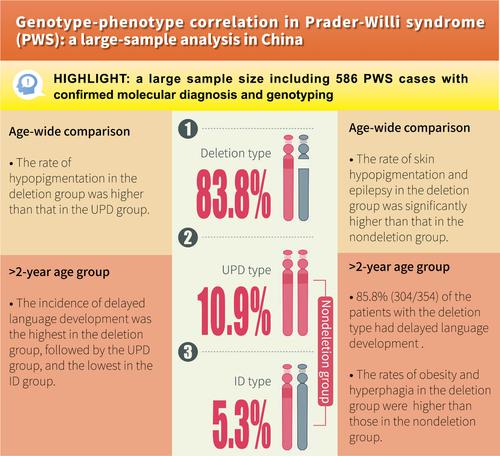当前位置:
X-MOL 学术
›
Clin. Genet.
›
论文详情
Our official English website, www.x-mol.net, welcomes your feedback! (Note: you will need to create a separate account there.)
Genotype–phenotype correlation in Prader-Willi syndrome: A large-sample analysis in China
Clinical Genetics ( IF 3.5 ) Pub Date : 2024-01-23 , DOI: 10.1111/cge.14477 Shujiong Mao 1, 2 , Lili Yang 1 , Ying Gao 3 , Chaochun Zou 1
Clinical Genetics ( IF 3.5 ) Pub Date : 2024-01-23 , DOI: 10.1111/cge.14477 Shujiong Mao 1, 2 , Lili Yang 1 , Ying Gao 3 , Chaochun Zou 1
Affiliation

|
The genotype–phenotype relationship in PWS patients is important for a better understanding of the clinical phenotype and clinical characteristics of different genotypes of PWS in children. We aimed to explore the influence of specific gene changes on the clinical symptoms of PWS and the value of early screening and early intervention of the condition. All data in this study were extracted from the database of the XiaoPang Weili Rare Disease Care Center. The collected information included basic demographics, maternal pregnancy information, endocrine abnormalities, growth and development abnormalities, and other clinical phenotypes. The relationships between genotypes and phenotypes in the major categories of PWS were analyzed. A total of 586 PWS cases with confirmed molecular diagnosis and genotyping were included in this study. Among them, 83.8% belonged to the deletion type, 10.9% the uniparental disomy (UPD) type, and 5.3% the imprinting defect (ID) type. Age-wide comparison among the three groups: The rate of hypopigmentation in the deletion group was higher than that in the UPD group (88.8% vs. 60.9%; p < 0.05); A total of 62 patients (14.2%) had epilepsy; and no statistical significance was found among the three groups (p = 0.110). Age-wide comparison between the deletion and non-deletion types: the rate of skin hypopigmentation and epilepsy in the deletion group was significantly higher than that in the non-deletion group (88.8% vs. 68.4%, p < 0.001; 15.9% vs. 7.6%, p = 0.040). The intergroup comparison for the >2-year age group: there were significant intergroup differences in the language development delay among the three groups (p < 0.001). The incidence of delayed language development was the highest in the deletion group, followed by the UPD group, and the lowest in the ID group. The rates of obesity and hyperphagia in the deletion group were also higher than those in the non-deletion group (71.1% vs. 58.9%, p = 0.041; 75.7% vs. 62.0%, p = 0.016). There are significant differences in the rates of skin hypopigmentation and language developmental delay among the deletion, UPD, and ID genotypes. The patients with deletion type had significantly higher rates of lighter skin color, obesity, hyperphagia, language developmental delay, and epilepsy. The results of this study will help clinicians better understand the impact of different PWS molecular etiologies on specific phenotypes.
更新日期:2024-01-23



























 京公网安备 11010802027423号
京公网安备 11010802027423号